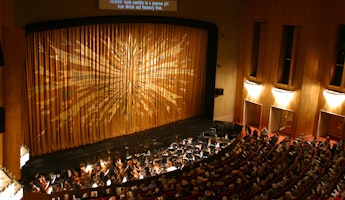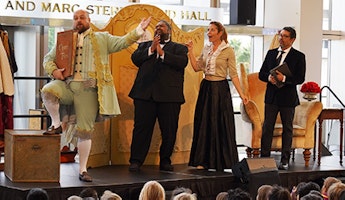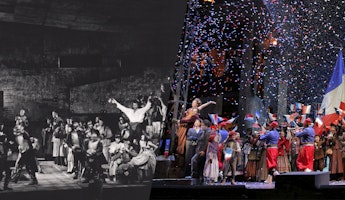Blog
November 14, 2022
Floria Tosca and the Freedom of the Artist
Tosca is one of the greatest works of music theater ever written and its importance is undiminished more than a century after Puccini wrote it. Its narrative is deceptively simple. It involves the lives of three principal characters. Mario Cavaradossi is a talented young painter, earning his living by creating ecclesiastical art in Roman churches. Floria Tosca, his lover, is a well-known classical singer, adored by her public. Baron Scarpia is the chief of police in a military state that is cracking down on all opposition together with the artistic freedom that sanctions it and draws support from it.
Cavaradossi hides a political friend who is fleeing for his life, and gets himself imprisoned and tortured for his pains. The corrupt Scarpia attempts to seduce Tosca, offering to release her lover if she gives in to his demands. Faced with watching her lover suffer further torture, Tosca laments her powerlessness in “Vissi d’arte,” one of the most heartrending arias in the grand opera repertoire. In trying to protect Cavaradossi from further agony, she agrees to betray his political friends. Cornered and ashamed, Tosca kills Scarpia and attempts to outwit the police in order to secure Cavaradossi’s freedom. In the Castel Sant’Angelo, surrounded by scores of other political prisoners, her plan fails and her lover is executed. Scarpia’s death is discovered and Tosca kills herself rather than yield to her captors.
The reason for the great popularity of Tosca is enshrined in its overwhelming musical, human, moral and religious powers.
Puccini’s score is utterly masterful. Its tightness of musical conception combined with the intimacy of its subject matter makes for extraordinary intensity, in orchestral color and sung line—in short, it is a musical masterwork.
The human drama that Puccini and his librettists adapted from Sardou’s original play constitutes a timeless plea for artistic and political freedom. In a world of fundamentalist philosophies, religious intolerance and political tyranny, Tosca stands as a beacon of enlightenment, a passionate plea for freedom of speech, thought and artistic expression. In any country that values its political freedoms, Tosca reminds us of what we have to lose, and the terrible price in human suffering if we cease to value what we truly believe in.
The moral and religious aspects of the story are far harder to pin down. At the beginning of the opera, the painted image that Cavaradossi is working on is that of a Mary Magdalene—a complex woman whose sexuality and experience seem to be in conflict with the teachings of her Master and therefore the teachings of the Church. She is also, at least in part, an image of Tosca herself—and in this production the Magdalene’s face has been fractured by the effects of war on the structure of the building in which she is to hang. In this respect the image takes on a dramatic irony. Tosca becomes a fractured character in the drama—as does the man who has imagined her as a redeemed Magdalene. The picture will never be completed, just as Tosca’s and Cavaradossi’s lives will never be completed.
Floria Tosca’s genuine religious devotion to the other image in the church, the image of the Virgin, makes us wonder about her inner life as an artist, from her earliest spiritual yearnings as a child right up to her sacrificial death as an adult. What was Tosca’s life like as a child? How did she develop as an artist? The original Sardou play gives us many of the answers. She came from a very poor background and was brought up in the church, the beauty of her voice redeeming her from a life of religious devotion. But as with many artists, the soul of the child has remained vividly alive in her. It is part of her artistry. Perhaps that is why she is so vulnerable to the corrupting demands of the real world. And so trusting.
The aspiration contained within the beauty of Cavaradossi’s ecclesiastical art is deeply envied by Scarpia and, like many an autocratic philistine, his envy turns into a collector’s ambition. The palace from which he works is crammed with banned and stolen art. But his ambition goes beyond objects to include people. He has Tosca, too, in his sights. His inability to understand her beauty and artistry makes him want to control it and if he can’t control it, destroy it. In short, he wants to add her to his collection.
Like his two lovers, Tosca and Cavaradossi, Puccini himself had a deeply divided attitude towards the church. In moral terms he was a passionate humanist, but like many men of his age, brought up in the faith of his forefathers, he could never completely escape from his feelings of religious fervor when faced with questions of belief or eternity. The evidence in this opera would seem to point to his humanism and Catholicism being all of a piece, inextricably entwined with his passion and integrity as an artist. And he certainly imbues his two heroic characters with the same synthesis of beliefs.
Floria Tosca’s decision not to be controlled by Scarpia, that her integrity as a woman and an artist is more important to her than life itself, leads her and Cavaradossi to their deaths. But even in the hopeless confines of the Castel Sant’Angelo, and in spite of everything he has seen, Cavaradossi still manages to believe in a future life of freedom and happiness for himself and his lover. The fact that he believes, against all the odds and all the evidence, is what makes his belief so moving. It is the same belief fueling the same artistic passion that he uses to breathe life into his painted canvas characters.
After Cavaradossi has been executed, Floria Tosca goes willingly to her death. Willingly because she cannot imagine living on after the man she has betrayed, but also because, in killing Scarpia, she knows or fears that she has become no better than him. She will meet him again before God. The God of her childhood faith will make the judgement, not them. In that sense she has become the Magdalene, trusting in the very faith from which she has never really drawn a benefit. Perhaps that is the meaning of true faith. And perhaps Puccini’s understanding of it can help us with our own faith in the limitless moral powers of artistic freedom.
John Caird is an acclaimed director and writer working in theater, opera and musical theater. He made his LA Opera debut with Tosca in 2013, returned to direct it again in 2017, and directs this season’s revival.








/03-cosi/_dsc0996_pr.jpg?format=auto&fit=crop&w=345&h=200&auto=format)















